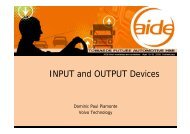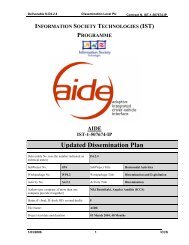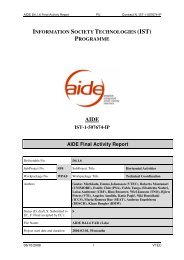download deliverable - AIDE
download deliverable - AIDE
download deliverable - AIDE
You also want an ePaper? Increase the reach of your titles
YUMPU automatically turns print PDFs into web optimized ePapers that Google loves.
Deliverable D4.2.1 Dissemination Level PU Contract N. IST-1-507674-IP<br />
• Improves the scalability of the architecture, since applications do not have to be<br />
changed for different system configurations (as well as during the integration phase<br />
and during the runtime (field) phase).<br />
• Application development is independent from the system behaviour and the ICA<br />
module, since no explicit priorities values have to be fed by the application to the ICA<br />
module. Therefore the architecture fulfils the requirement of modularity.<br />
• The applications and the context can be objectively categorized.<br />
• The generalized categorizations of the context and characteristics of application I/O<br />
reduce the complexity to be handled.<br />
Thus, central intelligence module of <strong>AIDE</strong> recognises an application in an abstract way,<br />
according to the provided action parameters. AMI-C’s intelligent kernel, on the other hand,<br />
has to know exactly the application.<br />
With respect to the dialogues priority class, it was argued that no conflict should be<br />
considered involving dialogues, since a user-initiated action signifies that the driver considers<br />
himself as capable of accomplishing the action. This is more obvious in situations where the<br />
initiator of the action is a passenger instead of the driver.<br />
Commenting on the metafunctions, it was argued that the action scheduling regarding<br />
visual messages should take into account the existence or not of a fellow-passenger in the<br />
front seats. It was also mentioned that most of the cars involve IVIS functions in a passengeroriented<br />
way.<br />
Dialogues should not be confused with output messages. Dialogues represent the<br />
initialization of a driver initiated action. It is when the driver starts a dialogue that the system<br />
should allocate an I/O device and this is the crucial moment for prioritization.<br />
3.9.3. Towards DVE-dependent HMI adaptation within <strong>AIDE</strong><br />
In order to adapt the system reaction to different aspects of availability, ability and<br />
traffic/environment conditions, in a personalized way, a Driver-Vehicle-Environment state<br />
was defined based on the considered dimensions of availability, ability and<br />
traffic/environment factors. There is no inherently “correct” set of DVE parameters since the<br />
relevant aspects are dependent on the HMI- and adaptation-strategy of the OEM. Thus, for the<br />
<strong>AIDE</strong> system, the relevant DVE parameters are those that are needed for implementing the<br />
defined (meta-) functions and scenarios. For example, if <strong>AIDE</strong> should implement adaptation<br />
of warning timing to driver distraction, we must be able to measure the DVE parameter<br />
distraction (which has to be clearly operationally defined). The selected DVE state<br />
dimensions are the followings: primary task demand, distraction, driver impairment,<br />
traffic/environment risk, driver intent and driver profile.<br />
25/07/2005 32 ICCS







